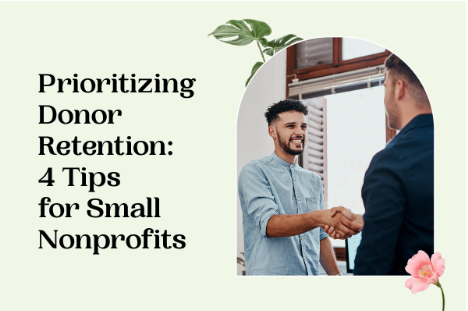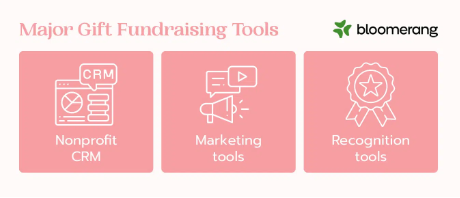
Growth is essential for nonprofits looking to do more good and expand their missions’ scope. This means fundraising professionals often put a lot of time and energy into attracting new supporters, getting their organization’s name out in the community, and securing the resources needed to grow.
While these are key aspects of growth, another overlooked but essential component is donor retention. If you attract 50 online donors, but only 20 of them stick around for the future, you’ll need to earn 30 new donors to make up for the lapsed supporters. With retention, you can get off the treadmill of acquiring and losing donors and instead set your organization up for real growth.
Retention is the key to growth, especially for smaller organizations where every individual donor has an immense impact. In this article, we’ll dive into tips that can help your nonprofit increase its retention rate and improve its growth. These tips include:
- Emphasize relationships.
- Explain the impact of donations.
- Show appreciation for all contributions.
- Provide additional engagement opportunities.
These strategies not only help you prevent donor lapse but also increase the value of your current supporters. This means that you’ll retain more donors, and many of them will likely be willing to make larger donations more frequently.
1. Emphasize relationships.
If you’ve only met someone once, would you call them on the phone to chat? Would you write them a letter? Give them money? Chances are, you’re much more likely to do all of those things for people you have an established relationship with, and the same principle holds true for your nonprofit’s supporters.
Nonprofits that establish relationships with their supporters are more likely to maintain their engagement for the long haul and earn their contributions, both now and in the future. As we look to the future of nonprofit fundraising, it’s clear that strong donor relationships will be many organizations’ saving grace for maintaining reliable revenue.
To develop these relationships, you’ll need to gather and leverage donor data. It’s likely impossible to keep all of your supporters’ information tucked away in your fundraising team’s brains, which is why tools like donor management software and constituent relationship management platforms (CRMs) are so important for relationship-building. Use this information to cultivate relationships by:
- Including supporters’ preferred names in email salutations
- Segmenting your supporters into groups and reaching out to them with updates that are relevant to their interests
- Tracking how often you reach out to your supporters to maintain consistent communications
Relationship building is important for almost all types of fundraising but is a necessity for your major gifts strategy. In fact, as Bloomerang’s guide to major gift fundraising explains, major gifts make up the bulk of most nonprofits’ total annual funding, and these supporters require one-on-one relationship cultivation. Bloomerang also shares a few tools nonprofits should use to advance their relationships with major donors:
 Alt text: Three types of major gift fundraising tools: nonprofit CRM, marketing tools, and recognition tools.
Alt text: Three types of major gift fundraising tools: nonprofit CRM, marketing tools, and recognition tools.
- Nonprofit CRM
- Marketing tools
- Recognition tools
We’ve already covered CRMs, but marketing and recognition tools can elevate your strategy. These platforms give your major gift officers the ability to create customized outreach and ensure no major giving prospects’ contributions go unrecognized.
2. Explain the impact of donations.
Donor lapse occurs for a number of reasons, one of which is that supporters are unsure how their donations are being used. Unfortunately, many supporters today are distrustful of charitable organizations and worry whether their donations are funding mission-related activities.
To address this issue, prioritize transparency and make it easy for supporters to understand how their individual contributions support your mission.
For instance, when a supporter gives to a specific program or campaign, follow up with them to share the impact that initiative has made. This might be in the form of a statistics report or a story from your beneficiaries. For instance, you might send a message like:
Your contribution to the Swim with Dolphins campaign helped raise the $100,000 that makes our dolphin-assisted therapy program more accessible to kids like Timmy. Timmy found friendship with Flipper, our oldest and gentlest dolphin pal. By working together, Timmy has seen enormous strides in his therapy and can continue his treatment.
These messages show your supporters what their gifts can do and demonstrates the value of your organization’s work, directly addressing two prominent reasons why donors stop giving to nonprofits.
3. Show appreciation for all contributions.
The first thank-you message donors receive from your nonprofit should be automatic and sent immediately after they make a contribution. However, a second follow-up can stick out to supporters, creating a memorable experience and increasing their goodwill toward your nonprofit.
There are plenty of opportunities to extend gratitude and show your supporters that you appreciate their contributions. We’ve pulled together some of the best tips for smaller nonprofits like yours:
- Write a letter. Leverage donor-centric language to put your supporters at the heart of the message, showing them how much you care about their involvement.
- Call your supporters. Your nonprofit can stand out above the crowd by making simple phone calls to thank donors and learn more about them. This is an especially effective strategy for cultivating relationships with new supporters.
- Send additional information. Donors give to your nonprofit because they feel moved by your mission. Lean into this by showing them just how impactful your mission is! In an appreciation email, send past newsletters, a welcome packet, or links to relevant educational content about your mission.
When it comes to which donors you should thank, the best answer is all of them. While you may not construct a donor appreciation wall for every $5 donation, each supporter deserves a thank-you of some kind. As such, have strategies in place for thanking recurring donors, peer-to-peer donors, planned donors, and other unique giving groups.
4. Provide additional engagement opportunities.
During times of economic turbulence, many supporters stop giving because they can no longer comfortably afford to do so. Fortunately, by offering non-donation-related opportunities, you can retain these supporters. In the future, when they have the budget to resume donating, you’ll be the first organization they turn to.
Plus, supporter involvement with other activities advances your mission in other ways. Consider engaging your supporters with:
- Events. Host events that are open to the public, and encourage your supporters to attend. This increases brand recognition in the community, provides an opportunity for supporters to engage with your organization directly, and allows them to learn about your cause.
- Peer-to-peer fundraising. Even if a supporter can’t give themselves, they can support your mission by raising funds from others! Ask your supporters to raise money on behalf of your organization in your next peer-to-peer campaign.
- Advocacy participation. There are a number of opportunities and activities that can support your organization’s mission. If you are involved with advocacy efforts, you might ask your donors to sign petitions, call legislators, and participate in social media movements.
- Volunteering. Volunteers make up a significant number of the nonprofit workforce, and more hands helping your mission is always a good thing. Kindful’s overview of volunteer management emphasizes the benefits of recruiting existing supporters into your volunteer program since these individuals have already demonstrated a commitment to your cause.
By asking supporters to get involved with more than just donations, you’ll drive engagement and help them form a hands-on connection with your mission.
While many nonprofits jump straight to their acquisition strategies when considering how to grow their organization, this is only half of the equation. You’ll make a bigger splash if you’re also able to retain the donors you acquire. Build an impactful retention strategy by putting donors at the forefront and treating each individual supporter with care.

















 I can’t wait to meet with you personally.
I can’t wait to meet with you personally.
Comments on this entry are closed.